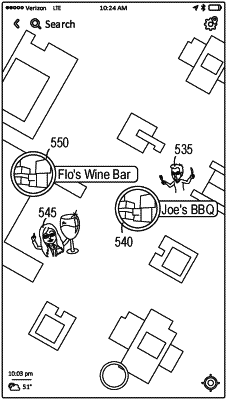| CPC G06Q 50/01 (2013.01) [G06F 16/487 (2019.01); H04L 51/222 (2022.05); H04L 51/52 (2022.05); H04L 51/10 (2013.01)] | 19 Claims |

|
1. A system comprising:
a processor; and
memory coupled to the processor and storing instructions that, when executed by the processor, cause the processor to perform operations comprising:
receiving, via a server, from a client computing device of a user, an electronic communication comprising:
location information from a location sensor coupled to the client computing device, the location information indicating a current location of the client computing device, and movement information of the client computing device;
determining, via the server, a current activity of the user based on the location information, determining a current activity comprising:
determining, via the server, that the user is traveling based on the movement information, wherein determining that the user is traveling comprises determining a type of travel;
generating, via the server, a first media content item comprising a map interface that includes the current location of the client computing device and an avatar of the user traveling at the current location based on the type of travel, the map interface being generated based on the location information and the avatar being generated based on avatar information for the user and the current activity;
causing, via the server, the first media content item to be displayed on a display screen of the client computing device;
identifying, via the server, a venue associated with the location information based on the client computing device transmitting the current location from inside the venue, wherein, in response to identifying that the venue is a restaurant, the current activity is determined to be eating based on the identified venue and on a social media post, and in response to identifying the venue is a bar, the current activity is determined to be drinking based on the identified venue and on the social media post;
generating, via the server, a second media content item comprising the map interface that includes the current location of the client computing device, and an identification data including a name of the venue being displayed at the current location in the map interface, and updating the avatar of the user to display the avatar holding an item to mimic the current activity being displayed at the current location in the map interface; and
causing, via the server, the second media content item to be displayed on a display screen of the client computing device.
|